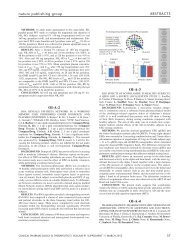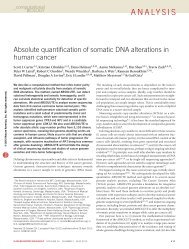open access: Nature Reviews: Key Advances in Medicine
open access: Nature Reviews: Key Advances in Medicine
open access: Nature Reviews: Key Advances in Medicine
Create successful ePaper yourself
Turn your PDF publications into a flip-book with our unique Google optimized e-Paper software.
have not been compared systematically to<br />
the cost of rema<strong>in</strong><strong>in</strong>g on dialysis. In addition,<br />
this study compared patient survival<br />
with liv<strong>in</strong>g donor transplantation follow<strong>in</strong>g<br />
desensitiza tion with those accrued on<br />
the waitlist. Whether these encourag<strong>in</strong>g<br />
observa tions could extend to deceased<br />
donor transplantation after successful<br />
desensitization rema<strong>in</strong>s to be seen.<br />
African Americans are at <strong>in</strong>creased risk<br />
of end-stage renal disease compared with<br />
white <strong>in</strong>dividuals. Recent studies suggest an<br />
association between variants of the apolipoprote<strong>in</strong><br />
L1 gene (APOL1) and nondiabetic<br />
nephropathy among African Americans. 5<br />
In a s<strong>in</strong>gle-center study, kidneys from<br />
African American deceased donors with<br />
two APOL1 risk variants were more likely to<br />
fail (HR 3.48, P = 0.008) than kidneys from<br />
<strong>in</strong>dividuals with one or no APOL1 risk variants.<br />
6 These associations outweighed the<br />
risk of graft loss associated with African<br />
American ancestry. This study highlights<br />
that transplant outcomes are more likely to<br />
be based on biology than on arbitrary and<br />
often culturally based def<strong>in</strong>itions of race.<br />
Whether or not donor genotype or donor–<br />
recipient genotype <strong>in</strong>teractions <strong>in</strong>fluence<br />
transplant outcomes through nonimmunological<br />
mechanisms demands confirmation.<br />
More importantly, the application of these<br />
associations to improve match<strong>in</strong>g of donors<br />
and recipients <strong>in</strong> organ allocation schemes<br />
merits further study.<br />
Successful transplantation <strong>in</strong> the cl<strong>in</strong>ical<br />
arena is <strong>in</strong>separable from the pharmacopeia<br />
that facilitates successful transplantation.<br />
Immunosuppressive drugs are associated<br />
with well-known immunological and nonimmunological<br />
adverse effects. However, it<br />
is <strong>in</strong>creas<strong>in</strong>gly apparent that a small number<br />
of recipients of renal and liver allografts<br />
cont<strong>in</strong>ue to have excellent graft function<br />
many years (sometimes decades) after<br />
stopp<strong>in</strong>g immunosuppression. Such <strong>in</strong>dividuals<br />
are described as be<strong>in</strong>g operationally<br />
tolerant. A unique B-cell expression signature<br />
associated with <strong>in</strong>creased numbers of<br />
naive and transitional B cells <strong>in</strong> peripheral<br />
blood has been described <strong>in</strong> operationally<br />
tolerant kidney transplant recipients. 7<br />
A recent study compar<strong>in</strong>g character istics<br />
of liver and kidney transplant recipients<br />
who are operationally tolerant showed<br />
that the gene-expression signatures of<br />
peripheral blood mononuclear cells <strong>in</strong><br />
these <strong>in</strong>dividuals was very different, with<br />
no significant detectable overlap between<br />
their immuno phenotypic profiles. 8 By contrast,<br />
tolerant and non tolerant liver recipients<br />
had similar peripheral blood B-cell<br />
phenotypic markers. 8<br />
‘‘ ...transplant outcomes are<br />
more likely to be based on biology<br />
than on arbitrary ... def<strong>in</strong>itions of<br />
race<br />
It is important to note that the studies<br />
discussed above represent associations and<br />
do not imply causal relationships. Patients<br />
who ma<strong>in</strong>ta<strong>in</strong> excellent graft survival<br />
despite discont<strong>in</strong>u<strong>in</strong>g immuno suppression<br />
might differ considerably from those who<br />
reject under similar circumstances; f<strong>in</strong>d<strong>in</strong>gs<br />
drawn from operationally tolerant<br />
<strong>in</strong>dividuals could therefore be affected<br />
by survivorship bias. Whether genomic<br />
and immunophenotypic markers associated<br />
with prolonged discont<strong>in</strong>uation of<br />
immuno suppression and excellent graft<br />
survival could be identified prospectively<br />
and enable programmed discont<strong>in</strong>uation<br />
of immunosuppression <strong>in</strong> selected recipients<br />
earlier <strong>in</strong> the course of transplantation<br />
deserves further systematic study.<br />
Extended criteria donor (ECD) kidneys<br />
permit successful transplantation especially<br />
among transplant candidates with<br />
poor expected waitlist survival, such as the<br />
elderly and those with diabetes. 9 However,<br />
delays <strong>in</strong> the placement of ECD kidneys are<br />
associated with <strong>in</strong>creased cold ischemia<br />
times (CITs) and a high rate of discard of<br />
such organs. A recent study us<strong>in</strong>g data from<br />
the Scientific Registry of Renal Transplant<br />
Recipients exam<strong>in</strong>ed the effect of <strong>in</strong>creas<strong>in</strong>g<br />
CITs on graft survival among recipients<br />
of paired kidneys (kidneys from the<br />
same deceased donor transplanted to<br />
two different recipients where one donor<br />
had delayed graft function and the other<br />
did not). 10 ’’<br />
Longer CITs were associated<br />
with <strong>in</strong>creas<strong>in</strong>g <strong>in</strong>cidence of delayed graft<br />
function. However, graft survival did not<br />
signifi cantly differ across the range of CITs<br />
studied. Although this study is limited by<br />
NEPHROLOGY<br />
its retrospective nature and is prone to<br />
selection bias, it provides some impetus to<br />
reconsider discard of ECD kidneys with<br />
higher CITs and optimize ECD utilization<br />
and acceptance.<br />
The articles summarized above provide<br />
food for thought and prospects for further<br />
<strong>in</strong>quiry <strong>in</strong> com<strong>in</strong>g years. We look forward<br />
to fruitful developments <strong>in</strong> these and related<br />
areas <strong>in</strong> cl<strong>in</strong>ical transplantation.<br />
Department of Nephrology and Hypertension,<br />
Glickman Urological and Kidney Institute, 9500<br />
Euclid Avenue, Cleveland, OH 44195, USA<br />
(T. R. Sr<strong>in</strong>ivas). Division of Nephrology,<br />
University of Arizona School of Medic<strong>in</strong>e,<br />
1501 North Campbell Avenue, Tucson,<br />
AZ 85724, USA (B. Kaplan).<br />
Correspondence to: B. Kaplan<br />
bkaplan@deptofmed.arizona.edu<br />
Compet<strong>in</strong>g <strong>in</strong>terests<br />
The authors declare no compet<strong>in</strong>g <strong>in</strong>terests.<br />
1. Larsen, C. P. et al. Rational development of<br />
LEA29Y (belatacept), a high-aff<strong>in</strong>ity variant of<br />
CTLA4-Ig with potent immunosuppressive<br />
properties. Am. J. Transplant. 5, 443–453<br />
(2005).<br />
2. V<strong>in</strong>centi, F. et al. A phase III study of belataceptbased<br />
immunosuppression regimens versus<br />
cyclospor<strong>in</strong>e <strong>in</strong> renal transplant recipients<br />
(BENEFIT study). Am. J. Transplant. 10,<br />
535–546 (2010).<br />
3. V<strong>in</strong>centi, F. et al. Three-year outcomes from<br />
BENEFIT, a randomized, active-controlled,<br />
parallel-group study <strong>in</strong> adult kidney transplant<br />
recipients. Am. J. Transplant. http://dx.doi.org/<br />
10.1111/j.1600–6143.2011.03785.x.<br />
4. Montgomery, R. A. et al. Desensitization <strong>in</strong> HLA<strong>in</strong>compatible<br />
kidney recipients and survival.<br />
N. Engl. J. Med. 365, 318–326 (2011).<br />
5. Friedman, D. J., Kozlit<strong>in</strong>a, J., Genovese, G.,<br />
Jog, P. & Pollak, M. R. Population-based risk<br />
assessment of APOL1 on renal disease. J. Am.<br />
Soc. Nephrol. 22, 2098–2105 (2011).<br />
6. Reeves-Daniel, A. M. et al. The APOL1 gene and<br />
allograft survival after kidney transplantation.<br />
Am. J. Transplant. 11, 1025–1030 (2011).<br />
7. Newell, K. A. et al. for the Immune Tolerance<br />
Network ST507 Study Group. Identification of a<br />
B cell signature associated with renal<br />
transplant tolerance <strong>in</strong> humans. J. Cl<strong>in</strong>. Invest.<br />
120, 1836–1847 (2010).<br />
8. Lozano, J. J. et al. Comparison of<br />
transcriptional and blood cell-phenotypic<br />
markers between operationally tolerant liver<br />
and kidney recipients. Am. J. Transplant. 11,<br />
1916–1926 (2011).<br />
9. Merion, R. M. et al. Deceased-donor<br />
characteristics and the survival benefit of<br />
kidney transplantation. JAMA 294, 2726–2733<br />
(2005).<br />
10. Kayler, L. K., Sr<strong>in</strong>ivas, T. R. & Schold, J. D.<br />
Influence of CIT-<strong>in</strong>duced DGF on kidney<br />
transplant outcomes. Am. J. Transplant. 11,<br />
2657–2664 (2011).<br />
KEY ADVANCES IN MEDICINE JANUARY 2012 | S53








